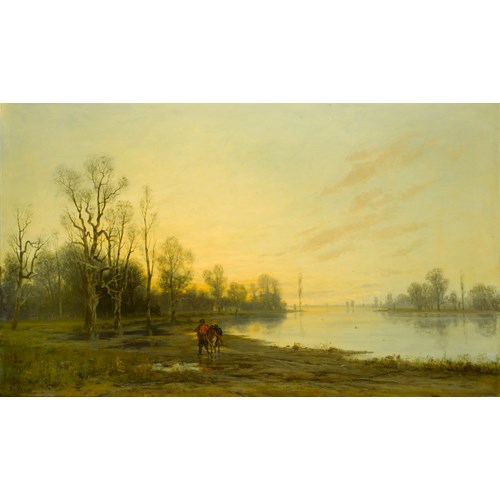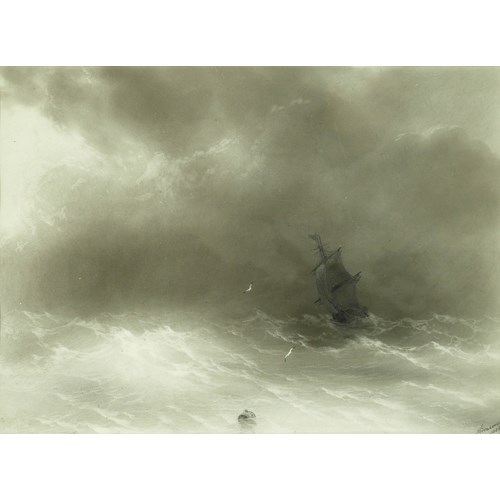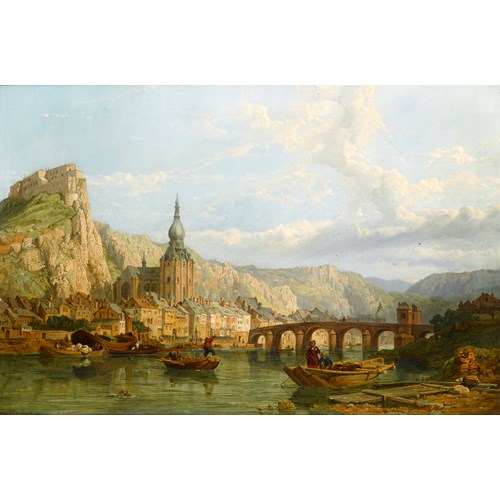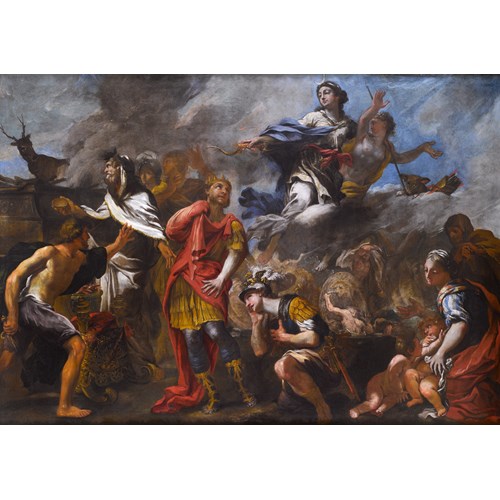Marketplace
Constantinople
Henri Duvieux
Constantinople
Epoque 1850-1900, 19th century
Origine France
Medium Oil on canvas
Dimension 40 x 65 cm (15³/₄ x 25⁵/₈ inches)
“There is probably nowhere in the world as majestic as that city; when you’re there you forget about Naples and Venice…”
- Ivan Aivazovsky, in a Letter to Count Zubov, written after his first trip to Constantinople in 1845.
In Constantinople Henri Duvieux presents us with a mesmerising view of the eponymous city from across the shores of the Bosphorus. The shadowy bank from where our viewpoint is taken is contrasted with the luminous and almost ephemeral glimmer of the city on the opposite side, its domes and minarets reflected in the shimmering waters. The Impressionistic colour and tones that Duvieux employs cleverly convey the intense light and brilliance of the city while movement is suggested by little flicks of brushstrokes dotted around the canvas.
The city of Constantinople inspired many artists of the nineteenth and twentieth centuries. With its sublime skyline, punctuated by the minarets of its monumental domed mosques, its bustling markets and squares, it was a hub for a multi-ethnic and artistic population who, along with Duvieux, were enraptured with it.
Duvieux’s clear passion for the city is seen throughout his career, with the majority of his complete works falling into two categories: either views of Constantinople and of the Bosphorus, or Venetian panoramas. This parallel interest is first noted at his debut of the Paris Salon in 1880, when at the age of only 25, he showed both Vue de Venise (View of Venice) and Vue de Constantinople (View of Constantinople). The majority of the views of Constantinople by Duvieux invariably incorporate aspects of the sea, in the tradition of the eighteenth century artist Canaletto, but also recall his contemporary Felix Ziem, a nineteenth-century French artist.
The Port of Istanbul, (Private Collection) is a further typical example of his Turkish scenes, comparable to the present work. Both paintings are composed in similar ways , with a thin slither of land on the left, giving way to the sparkling blue of the Bosphorus, beyond which the majestic sight of Constantinople rises up in the background. Executed in his characteristic loose and expressive brushstrokes, sky, sea and city almost merge together to give a vivid impression of the city.
Duvieux was born in 1855 in Paris. He entered his artistic studies as a student of Marilhat and after his debut at the Paris Salon in 1880 he continued to depict representations of Venice and Constantinople throughout his career. Other paintings based on Venice were Le Grand Canal a Venise (The Grand Canal at Venice), Coucher de Soleil a Venise (Sun Setting, Venice), and Panorama avec Voiliers et Gondoles a Venise (Venetian Panorama with Sailboats and Gondolas). His other paintings of Constantinople include Vue de Constantinople au Soleil Couchant (View of Constantinople with the Sun Setting).
Duvieux was influenced by the considerable nineteenth-century interest in Orientalism but he chose to concentrate his interest on landscapes and architecture and the effect of differing conditions of light in relation to them. He followed up his 1880 Salon debut by showing Campement Arabe (Arab Encampment) in 1882, which also marked his final appearance at the Salon. His paintings proved popular, striking a note with the considerable audience to whom this type of imagery appealed, acting as a memento of their travels
- Ivan Aivazovsky, in a Letter to Count Zubov, written after his first trip to Constantinople in 1845.
In Constantinople Henri Duvieux presents us with a mesmerising view of the eponymous city from across the shores of the Bosphorus. The shadowy bank from where our viewpoint is taken is contrasted with the luminous and almost ephemeral glimmer of the city on the opposite side, its domes and minarets reflected in the shimmering waters. The Impressionistic colour and tones that Duvieux employs cleverly convey the intense light and brilliance of the city while movement is suggested by little flicks of brushstrokes dotted around the canvas.
The city of Constantinople inspired many artists of the nineteenth and twentieth centuries. With its sublime skyline, punctuated by the minarets of its monumental domed mosques, its bustling markets and squares, it was a hub for a multi-ethnic and artistic population who, along with Duvieux, were enraptured with it.
Duvieux’s clear passion for the city is seen throughout his career, with the majority of his complete works falling into two categories: either views of Constantinople and of the Bosphorus, or Venetian panoramas. This parallel interest is first noted at his debut of the Paris Salon in 1880, when at the age of only 25, he showed both Vue de Venise (View of Venice) and Vue de Constantinople (View of Constantinople). The majority of the views of Constantinople by Duvieux invariably incorporate aspects of the sea, in the tradition of the eighteenth century artist Canaletto, but also recall his contemporary Felix Ziem, a nineteenth-century French artist.
The Port of Istanbul, (Private Collection) is a further typical example of his Turkish scenes, comparable to the present work. Both paintings are composed in similar ways , with a thin slither of land on the left, giving way to the sparkling blue of the Bosphorus, beyond which the majestic sight of Constantinople rises up in the background. Executed in his characteristic loose and expressive brushstrokes, sky, sea and city almost merge together to give a vivid impression of the city.
Duvieux was born in 1855 in Paris. He entered his artistic studies as a student of Marilhat and after his debut at the Paris Salon in 1880 he continued to depict representations of Venice and Constantinople throughout his career. Other paintings based on Venice were Le Grand Canal a Venise (The Grand Canal at Venice), Coucher de Soleil a Venise (Sun Setting, Venice), and Panorama avec Voiliers et Gondoles a Venise (Venetian Panorama with Sailboats and Gondolas). His other paintings of Constantinople include Vue de Constantinople au Soleil Couchant (View of Constantinople with the Sun Setting).
Duvieux was influenced by the considerable nineteenth-century interest in Orientalism but he chose to concentrate his interest on landscapes and architecture and the effect of differing conditions of light in relation to them. He followed up his 1880 Salon debut by showing Campement Arabe (Arab Encampment) in 1882, which also marked his final appearance at the Salon. His paintings proved popular, striking a note with the considerable audience to whom this type of imagery appealed, acting as a memento of their travels
Epoque: 1850-1900, 19th century
Origine: France
Medium: Oil on canvas
Signature: Signed ‘Duvieux’ (lower left)
Dimension: 40 x 65 cm (15³/₄ x 25⁵/₈ inches)
Plus d'œuvres d'art de la Galerie









